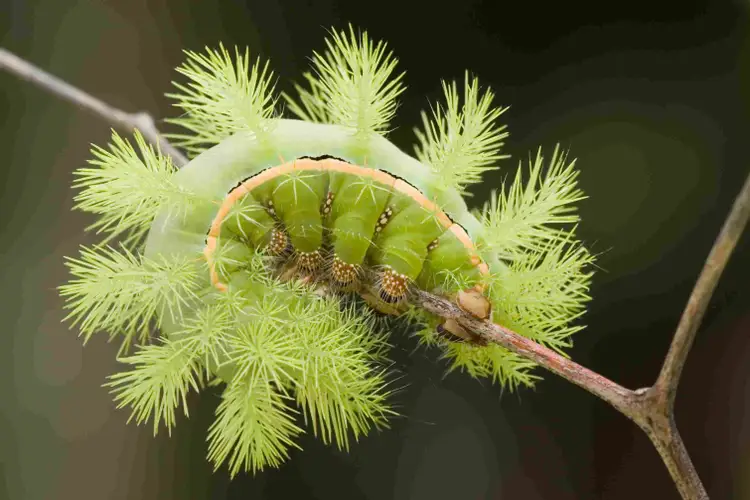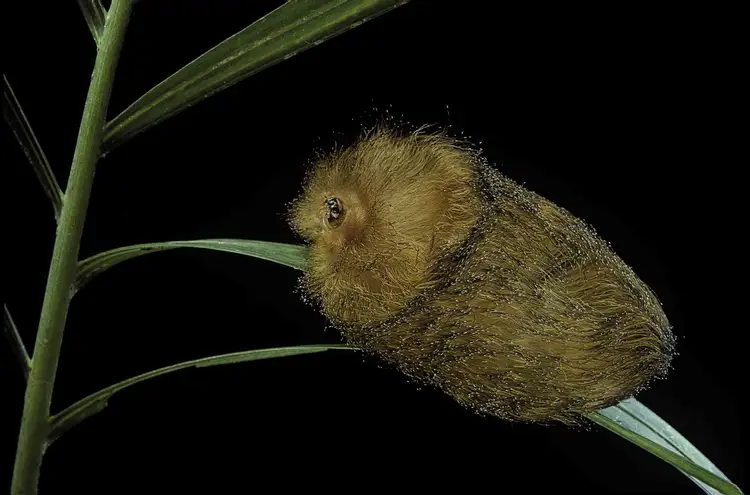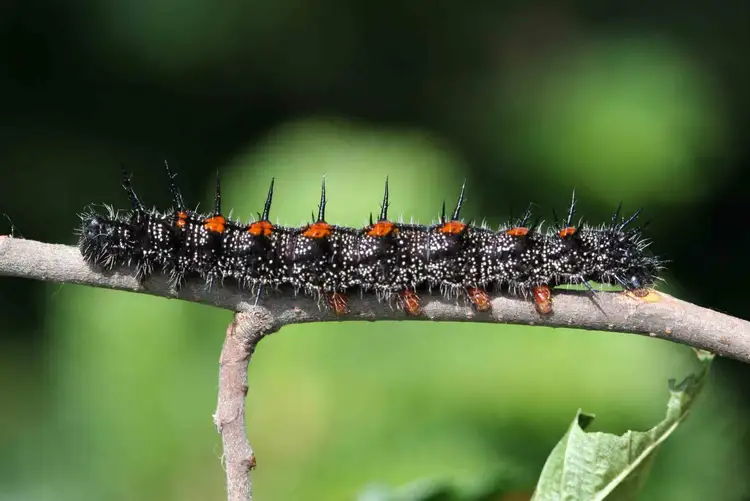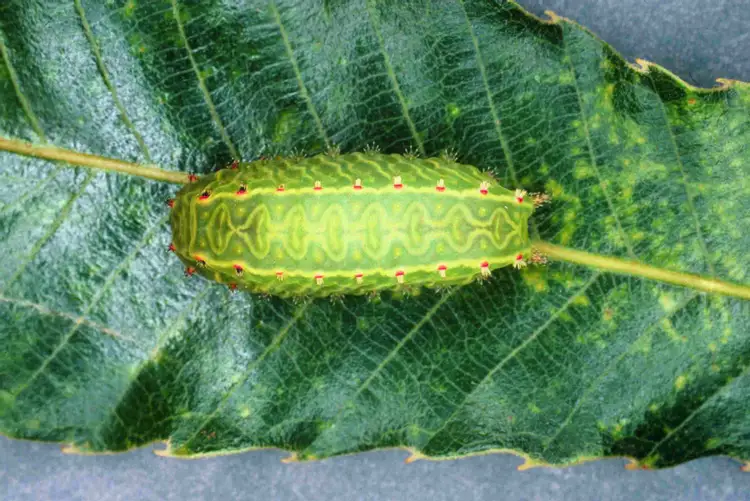Tabla de Contenidos
It is a caterpillar that attracts attention. The crowned slug displays its spines like the feathered headdress of a Parisian or Las Vegas showgirl. Stinging spines line the perimeter of the crowned slug, decorating its green, flattened body. In growth stages the caterpillar may also exhibit red or yellow spots along its back.
species and group
Isa textulates. Slug caterpillars (family Limacodidae).
Where do you find it?
In forests. In the United States from Florida to Mississippi, northern Minnesota and Massachusetts, and southern Ontario in Canada.
That eats?
Mainly oak, but also elm, hickory, maple, and other woody plants.
3. Caterpillar of the Io moth

With thorny branches filled with venom, this moth caterpillar is very much up for a fight. It lays eggs in clusters, so in the early stages of its development it will also be seen in clusters, dark brown in color, gradually changing from brown to orange, and finally to the green color of the one in the photograph.
species and group
Automeris io . Giant silkworm and royal moths (family Saturniidae).
Where do you find it?
In fields and forests from southern Canada to Florida and Texas in the United States.
That eats?
It has a varied diet: sassafras, willow, poplar, cherry, elm, hackberry, and other trees; also clover, grass and other herbaceous plants.
4. Witch moth caterpillar

The hag moth caterpillar is also often called a “monkey slug,” a name that, when you see it, is fitting. It’s hard to even believe it’s a caterpillar. The monkey slug can be instantly identified by its furry-looking “arms”, which can be detached. But beware: this adorable caterpillar is covered in tiny stinging spines.
species and group
Phobetron pithecium . Slug caterpillars (family Limacodidae).
Where do you find it?
In fields and forests. In the United States from Florida to Arkansas, and north to Quebec in Canada and Maine.
That eats?
Apple, cherry, persimmon, chestnut, walnut, oak, willow, birch, and other woody trees and shrubs.
5. Cat caterpillar

It looks like you could reach out and pet the cat caterpillar, but looks can be deceiving. Beneath that long blond hair hide poisonous thorns. Even a shed of skin from this caterpillar can cause a severe skin reaction, so don’t touch anything that looks like it. The cat caterpillar can grow to more than two centimeters in length. Cat caterpillars are larvae of the southern flannel moth.
species and group
Megalopyge opercularis. Flannel moths (family Megalopygidae).
Where do you find it?
In forests in the United States, from Maryland south to Florida, and west to Texas.
That eats?
Leaves of woody plants such as apple, birch, hackberry, oak, persimmon, almond, and walnut.
6. Spiny elm caterpillar

Although most stinging caterpillars become moths, the spiny elm caterpillar will one day make a beautiful mourning cloak butterfly. Spiny elm caterpillars live and feed in groups.
species and group
Nymphalis antiopa. Brush-footed butterflies (family Nymphalidae).
Where do you find it?
In wetlands, at the edge of forests and even in urban parks; in the United States from Florida north to Texas and north to Canada, in Mexico, and in Eurasia from England to Japan.
That eats?
Elm, birch, hackberry, willow and poplar.
7. Caterpillar of the white flannel moth

The caterpillar of the white flannel moth resembles anything but flannel to the touch: it is spiny. If you look closely you will see long hairs extending from its sides. Groups of shorter, stinging spines line the back and sides. The adult moth is white, as the name suggests, but the larva is a striking color combination of black, yellow, and orange.
species and group
Ovine norape . Flannel moths (family Megalopygidae).
Where do you find it?
In fields and woods; in the United States from Virginia to Missouri, and south to Florida and Texas, as well as in Mexico, Guatemala, Panama, Venezuela, Suriname, and Bolivia.
That eats?
Redbud, hackberry, elm, black locust, oak, and other woody plants, as well as cozolmecatl vine.
8. Pink stinging caterpillar

The pink stinging caterpillar does exactly that: sting. Its color can vary from yellow to red. To identify it, look at the pattern of the striped fabric: four dark stripes along the back, with cream-colored stripes between them.
species and group
Parase indeterminate. Slug caterpillars (family Limacodidae).
Where do you find it?
In arid, scrubby coastal areas; in the United States from Illinois to New York, and south to Texas and Florida.
That eats?
Woody plants such as dogwood, maple, oak, cherry, apple, poplar, and walnut.
9. Nason’s slimy caterpillar

Nason’s slugs don’t have the biggest spines in the caterpillar world, but they can still sting. These small spines retract, but if the Nason’s slug feels threatened it can quickly extend the venomous spines. If you look at the caterpillar from the front you will notice that its body has a trapezoidal shape (it cannot be seen in this photo).
species and group
Natada nasoni. Slug caterpillars (family Limacodidae).
Where do you find it?
In forests; in the United States from Florida to Mississippi, north to Missouri and New York, in Mexico and in Costa Rica.
That eats?
Trees such as hornbeam, oak, chestnut, beech and walnut.
10. Caterpillar of the spotted dagger moth

This is another stinging caterpillar that exhibits different colors. Note the yellow spots on each side of its body and the raised red spots on its back. The spotted dagger moth caterpillar is also known as the persicaria (smartweed) caterpillar, as it is one of its preferred plant hosts.
species and group
Oblinite acronicta. Little owls, cutworms and catocalas (family Noctuidae).
Where do you find it?
On beaches, marshes and moors; in the United States from Florida and Texas to southern Canada.
That eats?
Broad-leaved herbaceous plants, as well as woody trees and shrubs.
11. Caterpillar of the stag moth

This black and white caterpillar uses branching spines to defend itself against predators. Like the Io moth caterpillar, the stag moth caterpillar lives gregariously in the early stages of its development. David L. Wagner, author of Caterpillar of Eastern North America , notes that a bite he received from a stag moth caterpillar was still visible ten days later, bleeding where the spines they had penetrated his skin.
species and group
Hemileuca maia. Giant silkworm and royal moths (family Saturniidae).
Where do you find it?
In oak forests; in the United States from Florida to Louisiana, north to Maine, passing through Missouri.
That eats?
young oak; developed caterpillars feed on most woody plants.
12. Caterpillar of the spiny oak slug

The spiny oak slug can display a rainbow of colors; the one we show in the photo is predominantly green. If you find a predominantly pink one you can recognize it by the four darker sets of spines near the rear end.
species and group
Euclea delphinii. Slug caterpillars (family Limacodidae).
Where do you find it?
In forests; in North America from Quebec south to Maine, and further south to Texas and Florida, via Missouri.
That eats?
Sycamore, willow, ash, oak, hackberry, chestnut, and other smaller woody plants.
13. Caterpillar of the white tuft moth

The caterpillar of the white tuft moth is easy to identify. To recognize this stinging caterpillar you have to take into account that its head is red, its back is black and it has yellow stripes on the sides. Several varieties of the white tufted moth caterpillar, including the one pictured here, are considered a pest of trees due to their voracity for woody plants.
species and group
Orgyia leucostigma . Tufted caterpillars (family Lymantriidae).
Where do you find it?
In forests; in North America from southern Canada to Florida and Texas.
That eats?
Almost any tree, both deciduous and evergreen.
References
- Treatise on Zoology; D’Ancona, Humberto; Editorial Labor, 1960



